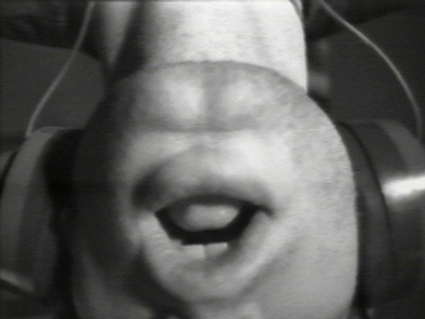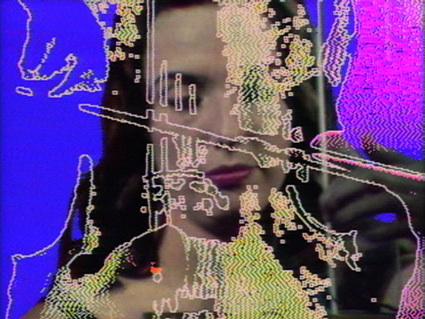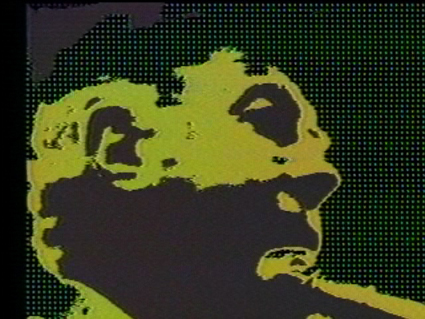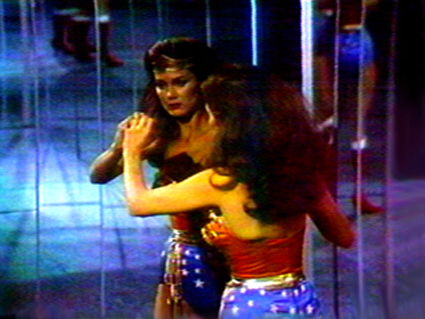more than a shadowy imposter
sarah-mace dennis: parallel universes, the block, qut

Bruce Nauman, Lip Sync, 1969 (video still)
image copyright of the artist, courtesy of Video Data Bank – www.vdb.org
Bruce Nauman, Lip Sync, 1969 (video still)
CURRENTLY I AM IN BRISBANE, THE TOWN WHERE IT SEEMS PART OF ME MUST HAVE GROWN UP. I FEEL GHOSTS HERE—SHADOWS THAT EMERGE FROM THE ECHOIC UNIVERSES THAT I HAVE WANDERED DURING MANY PAST LIVES. UNLIKE THE ARTISTS FEATURED IN THE EXHIBITION I AM ABOUT TO ENTER, I HAVEN’T ALWAYS USED A CAMERA TO RECORD THE CONDITIONS OF MY EXISTENCE. STILL, MY PERCEPTUAL FIELDING OF THE WORLD IS ENTANGLED INSIDE ENDLESS VERSIONS OF REALITY: MEDIATED TRUTHS THAT HAVE BEEN SEQUENCED INSIDE MANY DIGITAL FRAMES.
Trying to decide which of the images in my head have come from the media and which have formed inside the unstable contours of a dream, I approach the exhibition space. Just as I know that the analogue video signal is on the verge of extinction, I am also aware that the world I am entering traces early artistic interventions into the creative and political possibilities of that signal. In particular this collection of works intends to activate connections between the ‘parallel’ conceptual and aesthetic concerns uncovered by artists in Australia, Britain, the United States and Japan between 1970 and 1985. These works are organised by their placement within three conceptual streams: “performance, identity and video,” ‘media is the message” and the ‘politics of narrative.”
Inside I find American artist Bruce Nauman’s upside down face, image cropped so that only his lips are visible, repeatedly uttering the words that give the video its title: lip sync, lip sync, lip sync (1969). But the movement of the mouth is not in sync with the image I am reading. In this work video makes strange the performance of what should be a logical and repeated action. In a similar conceptual provocation, Joan Jonas’ Vertical Roll (1972) realises the potential of the rolling scan lines that were considered a mistake in broadcast. Inside the glitch a woman’s body turns, her contours punctuated and cut by the repeated visual beat of the image’s vertical roll.
In Idea Demonstrations (1972), Mike Parr and Peter Kennedy extend the possibilities that moving image offers for editing and destabilising dominant representations of the body. In this work—documenting a series of performative collaborations by the artists—Parr stares quietly into camera. Blinking, he holds his damaged limb. This sequence is embedded inside other performances. A hand removes shoes from bodies lying on a floor. A man repeatedly attaches bulldog clips to the skin around his nipples.
Like Naumann and Jonas, these artists were experimenting with the possibilities that the cinematic frame offered for editing, destabilising and re-performing stereotypical representations of the body. For Kennedy and Parr, the camera becomes a psychological tool that mediates and strategically positions the performer in front of the audience. In fact, because of this work’s emphasis on the act of recording, the artists found the emerging technology of video too unpredictable. For this reason they recorded this project on 16mm film, only later transferring the work to DVD.

Nam June Paik and John Godfrey, Global Groove, 1973
Courtesy Electronic Arts Intermix (EAI), New York
Nam June Paik and John Godfrey, Global Groove, 1973
Gathered together as a result of the conceptual resonance they share with Marshall McLuhan’s affirmation that “the media is the message,” the gently strobing works on the second configuration of screens unravel a conversation about the potential for video art to conceptually and structurally extend the media landscape from which it emerges. Here video offers new possibilities for reshaping cognitive awareness and altering cultural experience.
In Nam June Paik’s Global Groove (1973) video provides the opportunity to imagine a future digital world. Paik choreographs a visual onslaught of digitally saturated imagery in which the auras of ethnic dancers and musicians are made strange by mechanical shadowing. Echoes of traditional cultural performance are electronically punctuated by the artificial pulse of fast-paced cuts and hyperreal backgrounds. Australian artist David Perry’s Mad Mesh (1968) is a digitally constructed landscape which almost transports my attention into the cathode ray tube.

John Hughes and Peter Kennedy, November Eleven, 1979-81 (video still)
courtesy of the artists
John Hughes and Peter Kennedy, November Eleven, 1979-81 (video still)
In the final space, I find a collection of works that explores the new textual possibilities facilitated by the video signal. Reconfiguring narrative conventions, these works unhinge the political momentum of dominant media codes. In Peter Kennedy and John Hughes’ November Eleven (1981), ‘scratch’ video techniques are used to re-imagine found media footage. Repositioning political statements, this video re-patterns the events surrounding Gough Whitlam’s dismissal as Prime Minister in 1975 to create a new story. Similarly, experimenting with repetition and visual effects, Dara Birnbaum’s Technology/Transformation: Wonder Woman (1978) deconstructs narrative strategies used by mainstream cinema, transforming expressions of feminine experience.

Dara Birnbaum, Technology/Transformation: Wonder Woman, 1978 – 1979 (video still)
image copyright of the artist, courtesy of Video Data Bank – www.vdb.org
Dara Birnbaum, Technology/Transformation: Wonder Woman, 1978 – 1979 (video still)
In the corridors surrounding the exhibition, I caught traces of a dialogue that started to evaluate the perception that video art was once a shadowy impostor lingering at the edges of cinematic tradition. When I started to think about these conversations I realised that video art inhabits a parallel cinematic space, one that begins to alter the formulas deployed inside dominant media frames. The early technical and conceptual accomplishments of the artists featured in this exhibition are not only experiments that reconfigured the media landscape, they are also important cinematic explorations that began to expand the possibilities of the moving image.
Parallel Universes, curators Dr Mark Pennings, Lubi Thomas, Rachael Parsons (QUT), Matthew Perkins (Monash University), The Block, QUT Creative Industries Precinct, Kelvin Grove; July 24-Aug 4; http://www.ciprecinct.qut.edu.au/whatson/exhibitions/parallel.jsp
RealTime issue #110 Aug-Sept 2012 pg. web






